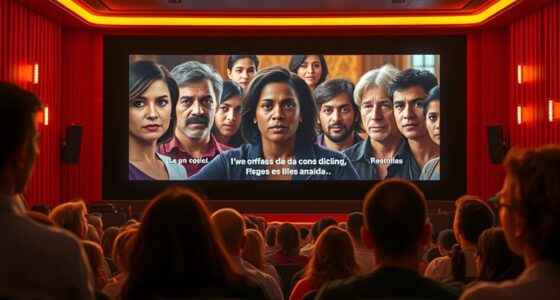To manage live-event dubbing, you need advanced technology like high-quality sound systems, real-time audio processing, and precise synchronization tools. You coordinate translation teams, voice actors, and technical staff to guarantee seamless audio delivery across multiple languages. Proper planning involves preparing language channels and using audio routing to prevent delays or overlaps. When executed well, this process creates an authentic, engaging experience for global audiences. Keep exploring to learn more about how these elements work together smoothly.
Key Takeaways
- Requires advanced audio capture, real-time translation, and synchronized voice-over technology to ensure seamless delivery.
- Involves meticulous planning and coordination among translation teams, voice actors, and technical staff.
- Utilizes multi-channel audio routing and synchronization tools for accurate lip-sync and minimal delays.
- Often pre-sets multiple language tracks for quick activation and viewer selection during live broadcasts.
- Demands high-quality sound systems and real-time processing to maintain translation accuracy and broadcast integrity.

Live-event dubbing brings real-time translation and voice-over to live broadcasts, allowing audiences around the world to experience events in their native language. As a viewer, you can enjoy concerts, sports, or conferences as if they were tailored specifically for your linguistic preferences. This technology isn’t just about language; it’s about creating a seamless experience that maximizes audience engagement. When done well, live dubbing captures the energy and emotion of the original event, making you feel connected regardless of language barriers. The key to achieving this lies in translation accuracy, guaranteeing that every word, phrase, and nuance is faithfully conveyed. Accurate translation prevents misunderstandings and preserves the integrity of the original content, which is crucial for maintaining viewer trust and satisfaction.
Live-event dubbing ensures seamless, accurate translation, connecting global audiences with authentic, engaging broadcasts across languages.
Executing live-event dubbing requires meticulous planning and sophisticated technology. You’ll find that high-quality sound systems, real-time audio processing, and skilled voice-over artists work together to deliver a smooth, synchronized broadcast. The process involves multiple stages: capturing the live audio feed, translating the content instantly, and then recording the voice-over in real time. This demands a well-coordinated effort among translation teams, voice actors, and technical staff. The goal is to produce a natural, engaging narration that aligns perfectly with the live action, so you don’t experience any jarring delays or mismatched audio. When the technology functions flawlessly, it creates an immersive environment that keeps you engrossed in the event.
Furthermore, the logistics of live dubbing involve managing multiple language tracks simultaneously, which can be complex but essential for global audiences. You might be surprised to learn that broadcasters often prepare for multiple language options beforehand, setting up dedicated channels for each. During a live event, these channels are activated seamlessly, allowing viewers to select their preferred language instantly. This requires precise timing and coordination to avoid overlaps or audio glitches. The technology also relies on advanced audio routing and synchronization tools to ensure that the dubbed voice-over matches the lip movements and timing of the original footage. When everything is in sync, it enhances audience engagement by making the experience feel natural and effortless, even in multiple languages. Additionally, translation accuracy plays a crucial role in ensuring the fidelity of the dubbed content, helping to maintain the emotional and contextual integrity of the original event.
Ultimately, live-event dubbing is a sophisticated blend of technology, translation expertise, and logistical precision. It’s designed to connect audiences worldwide, breaking down language barriers and creating shared experiences. When executed with attention to translation accuracy and technical finesse, it transforms a live broadcast into a universally accessible event. As a viewer, you benefit from this seamless integration, feeling fully immersed regardless of your native language. The result is a dynamic, engaging broadcast that resonates across cultures and borders, making every global event feel local and personal.
Frequently Asked Questions
How Do Time Zone Differences Affect Live-Event Dubbing Schedules?
Time zone differences greatly impact your live-event dubbing schedules by creating scheduling challenges and necessitating precise time zone coordination. You must carefully plan recording sessions, syncing actors and technical teams across various locations. These differences can lead to delays or miscommunications if not managed properly. To overcome this, you should establish clear timelines, use reliable communication tools, and coordinate with all teams to ensure smooth, timely dubbing processes despite the time zone gaps.
What Are the Environmental Considerations for Outdoor Live-Event Dubbing Setups?
When setting up outdoor live-event dubbing, you should prioritize environmental considerations by using sustainable materials for equipment and structures. Opt for renewable energy sources like portable solar panels to power your gear, reducing carbon footprint. Protect sensitive equipment from weather with eco-friendly covers, and minimize waste by recycling. These steps help guarantee your dubbing setup remains environmentally responsible while maintaining high-quality audio performance in outdoor settings.
How Is Latency Minimized During Live Dubbing for Real-Time Synchronization?
You minimize latency during live dubbing by optimizing audio synchronization and reducing transmission delay. Use high-quality, low-latency audio equipment and digital transmission methods to guarantee signals arrive quickly and accurately. Implement real-time monitoring and synchronization tools that automatically adjust for any delays, keeping audio perfectly aligned with video. This approach ensures seamless integration, so viewers experience a smooth, professional broadcast without noticeable lag or desynchronization.
What Are the Backup Systems Used in Case of Technical Failures?
Think of backup systems as your safety net during a high-wire act. If a technical failure occurs, you rely on redundant servers and backup power to keep everything running smoothly. These systems automatically take over, ensuring no interruption in the live dubbing. They act as your insurance, catching you when the primary system falters, so you maintain seamless synchronization and professionalism throughout the event.
How Do Different Languages Impact the Dubbing Equipment Requirements?
Different languages impact your dubbing equipment requirements because language nuances demand precise audio capture and synchronization. You need adaptable equipment that can handle various speech patterns, tonal variations, and lip-sync challenges. For example, some languages may require different microphone setups or sound processing tools to preserve the original intent and clarity. By investing in versatile, adaptable equipment, you guarantee accurate, high-quality dubbing across diverse languages and audience expectations.
Conclusion
As you can see, live-event dubbing combines complex logistics with cutting-edge technology to deliver seamless experiences. Did you know that over 80% of global broadcasters now rely on real-time dubbing for live events? This shows how essential quick, accurate localization is for engaging diverse audiences. By understanding these processes, you can better appreciate the incredible effort behind every live broadcast, ensuring everyone gets to enjoy the event in their native language without missing a beat.









